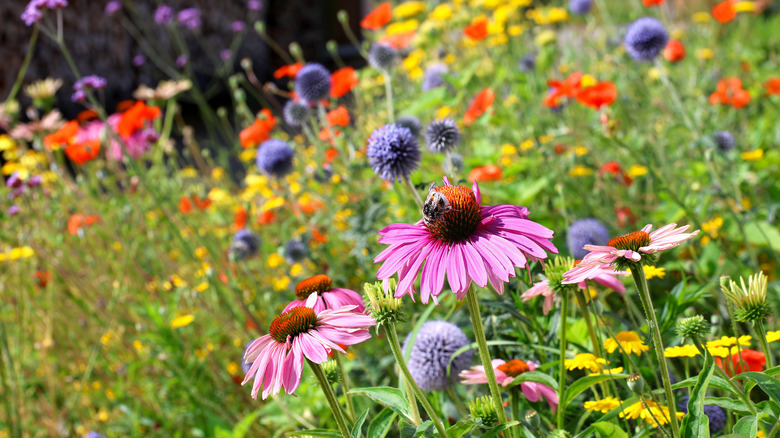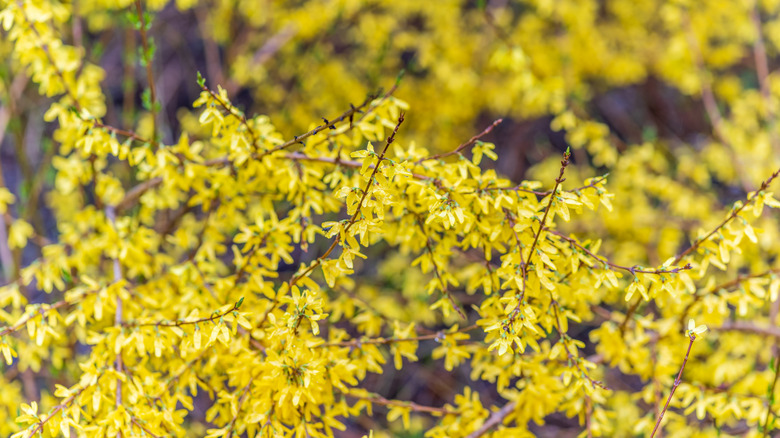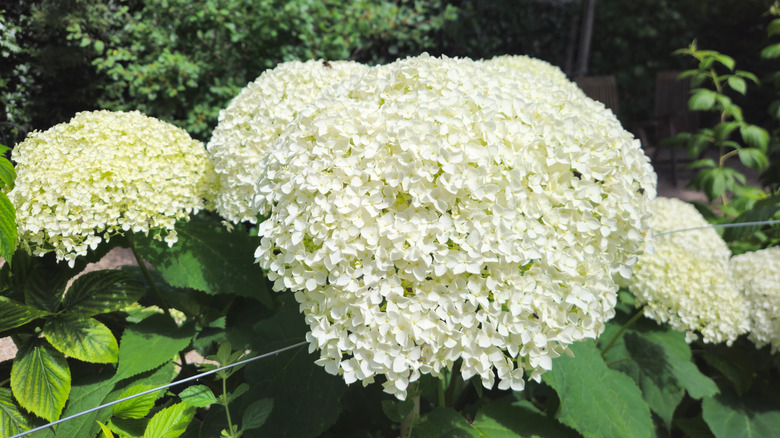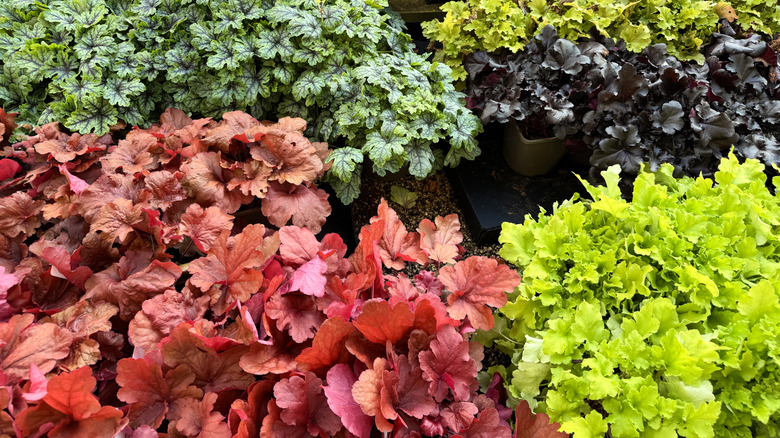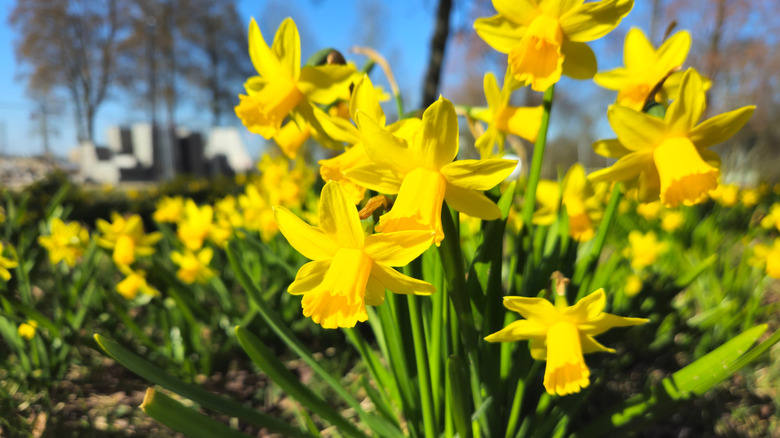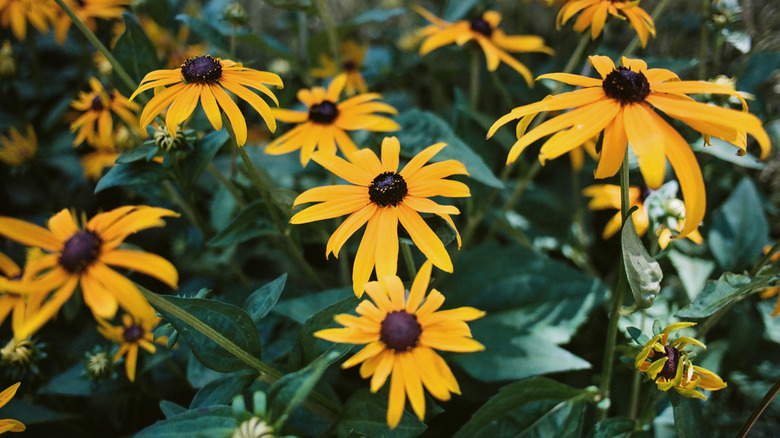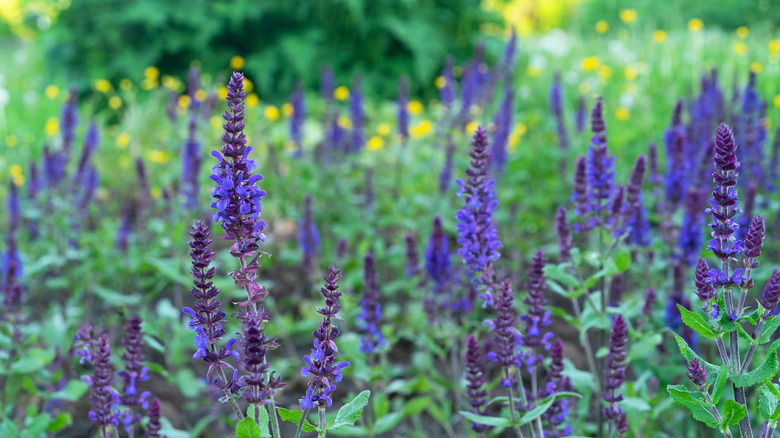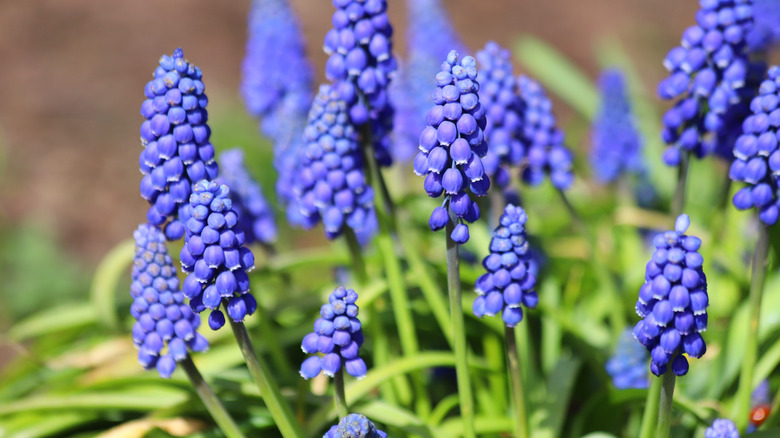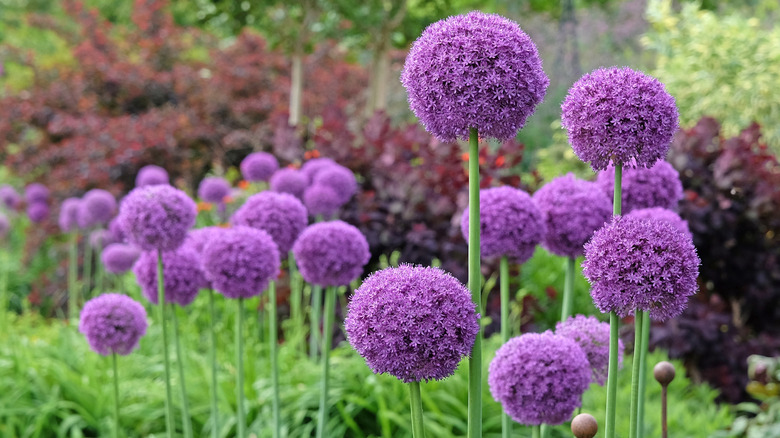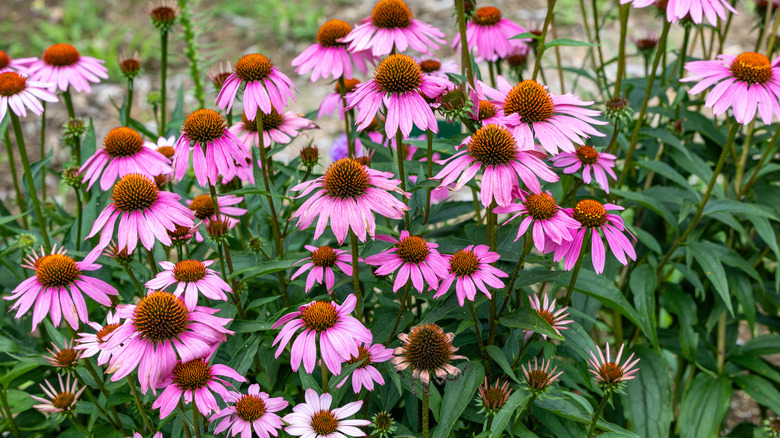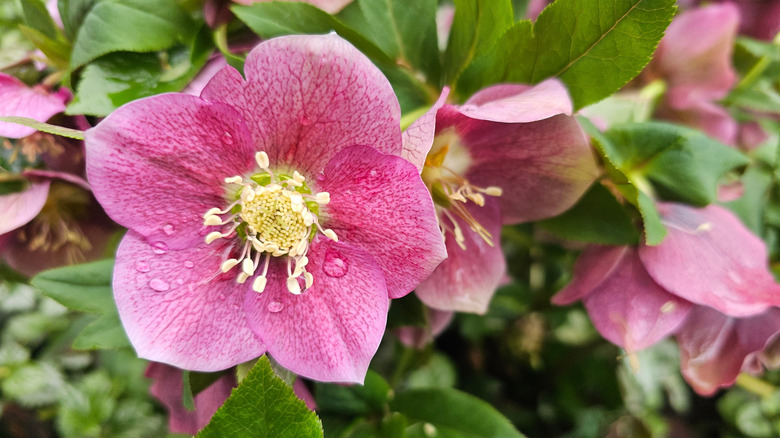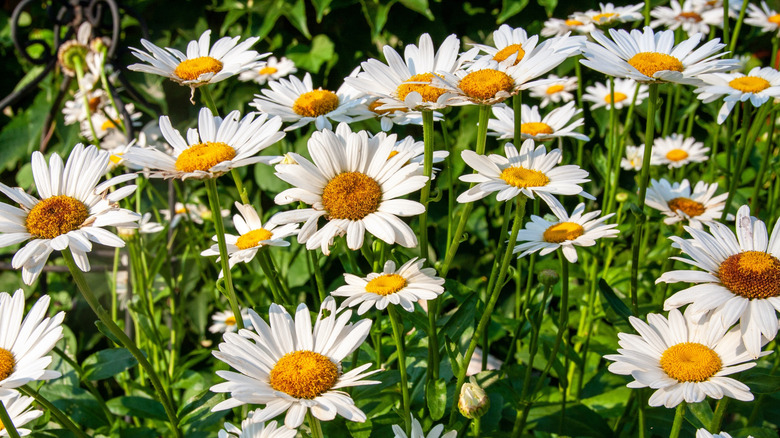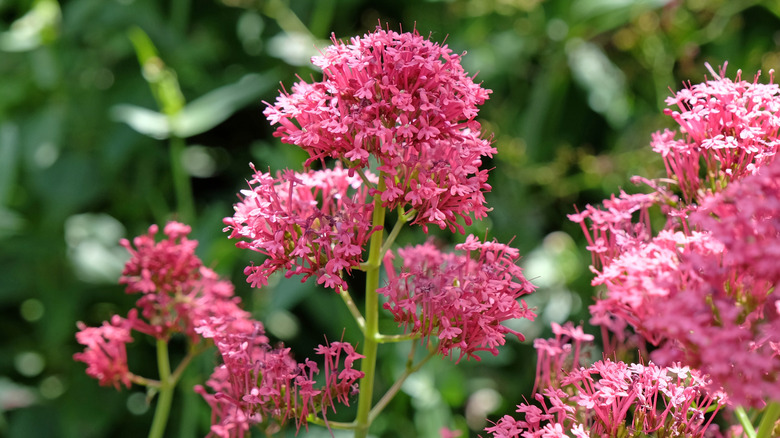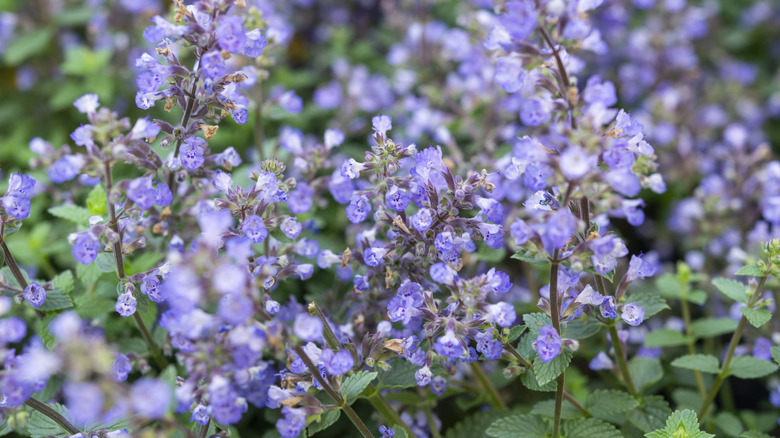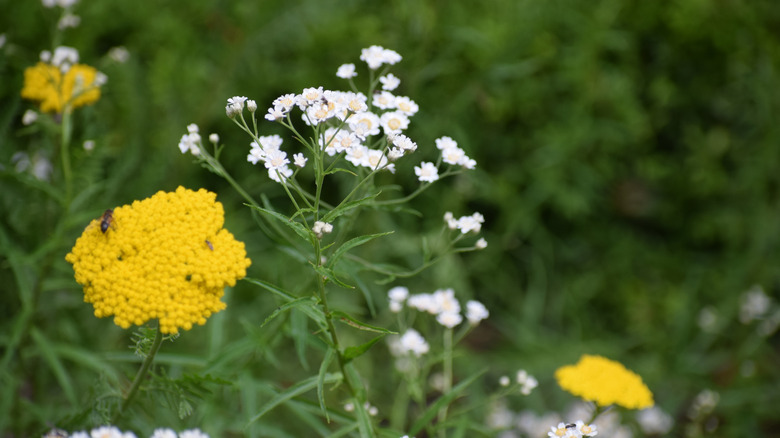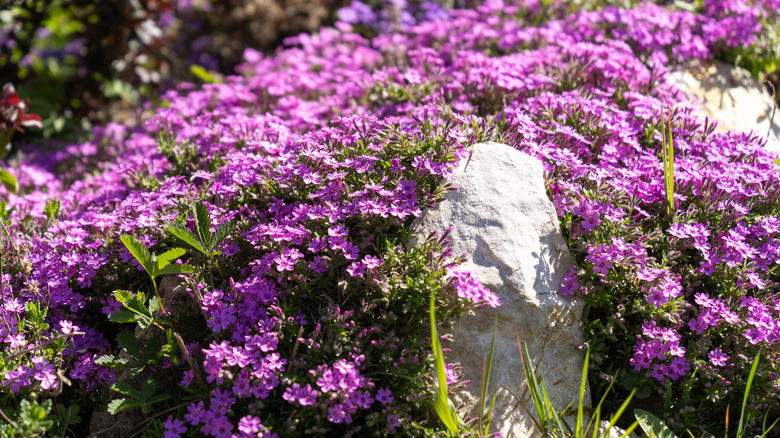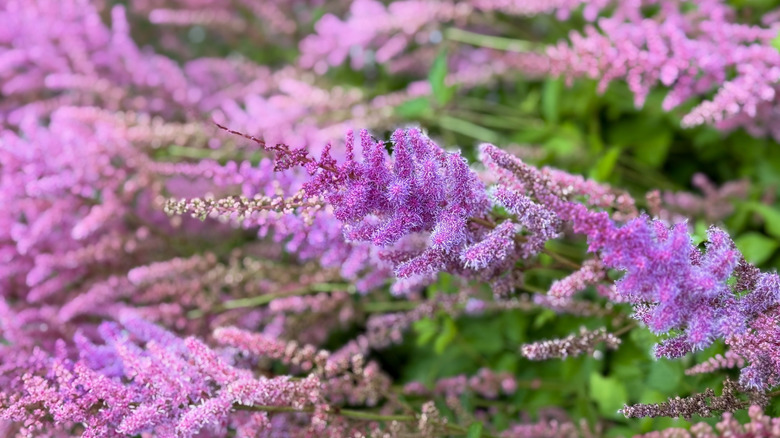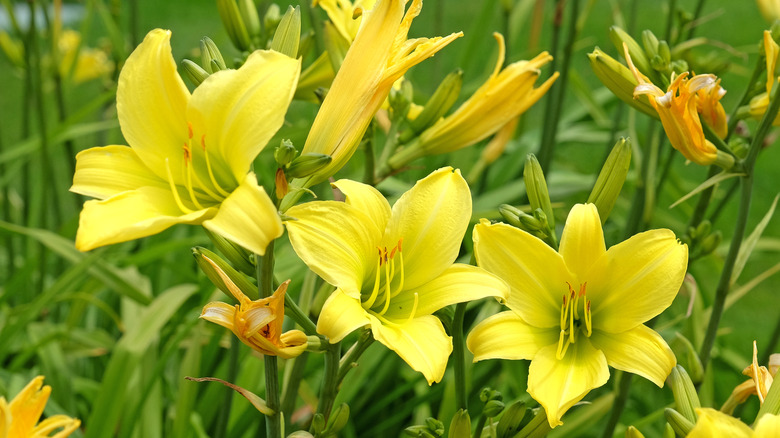17 Best Perennials You Should Be Planting In October
As long as the soil in your garden is still workable, October is a perfectly good time of year to plant perennials. It's actually preferable for many different species. Since perennials reliably grow back season after season, establishing them now means you'll get to enjoy the full duration of their growing season once warmer weather arrives next year.
That comes with one big caveat: You'll need to be mindful of the weather as this month stretches on. Once frost is in the forecast for your area, or temperatures get low enough near you that the ground starts to freeze over, the probability of your new plant taking root and getting enough water to grow back later will dwindle rapidly. If you live somewhere that gets cold during the fall and winter, it's best to choose plants that are at least somewhat cold-hardy. Whether you're thinking of growing low-maintenance perennial plants that hardly need any attention to thrive or simply looking to add some new plant varieties to your yard, here are 17 different types of perennials that you can (and should!) consider planting in your garden in October.
Forysthia
Beloved for its vibrant, densely packed yellow blooms, forsythia (Forsythia spp.) is a shrub that's perfect for adding a cheery burst of color to an otherwise drab garden. As a bonus, it's one of those perennial plants that attracts pollinators. It's fast-growing and low-maintenance, which bodes well for planting it successfully in October, and fares best in USDA Hardiness Zones 5 through 9. Many varieties of this plant are quite hardy and can tolerate winter weather conditions, though, in some cases, prolonged exposure to extreme cold can delay its growth.
Hydrangeas
With their lush, emerald-green leaves and showy flowers that come in a range of colors, hydrangeas (Hydrangea spp.) would make a lovely addition to any garden. Fall is typically the best time of year to plant these perennials, though that can vary depending on the weather conditions near you. Hydrangeas are hardy in Zones 3 through 9 and do best in full or partial sun; once established, they're easy to care for. Plant them directly in your garden or in planters on your back porch. Beware, though: Hydrangeas are known to attract certain pests, including aphids, weevils, and scales.
Coral bells
As the name suggests, coral bells (Heuchera spp.) are beloved for their colorful leaves that are shaped like bells. They can add a pop of saturation that's the perfect support for your other, showier plants. Coral bells are native to woodlands and prairies throughout North America. They're suitable evergreens for Zones 4 through 9, make great ground cover plants, and do well when planted in spring or fall. Plant yours in a shady spot, leaving 1 to 2 inches of space between each plant for breathing room.
Mini daffodils
You've probably heard of daffodils (Narcissus spp.), but are you familiar with mini daffodils (Narcissus cyclamineus)? These flowering perennials boast the same bright blooms and easy-care regimen as standard daffodils, they're just shorter in stature, reaching anywhere between 6 to 8 inches in height once mature. They're perfect for planters or rock gardens. Hardy in Zones 3 through 8, mini daffodils like full sun or partial shade and average soil. Plant yours in groups in October, and you'll reap the benefits in early springtime, when their flowers shoot up from the ground.
Black-eyed Susan
A mainstay for pollinator gardens, black-eyed Susans (Rudbeckia hirta) are native perennials that are easy to grow and gorgeous to look at. Their golden, daisy-like flowers would jazz up any garden or yard. Black-eyed Susans are suitable for Hardiness Zones 3 through 9 and bloom late into the summer, sometimes early fall. Though these flowers thrive in summer heat once established, it's actually recommended that you avoid planting them in the summer and instead grow them in the fall. Establish yours in a spot with fertile, well-drained soil and full sun.
Russian sage
Are you a fan of purple? Look no further than Russian sage (Salvia yangii), a gorgeous flowering perennial. Its spindling purple blooms grow vertically, making it a good pick for anyone looking to add height or volume to their garden or yard. Hardy in Zones 4 through 9, Russian sage flowers in mid to late summer and early fall. However, October is a great time to establish it — this plant can be successfully grown in late spring or early fall. You won't have to worry about babysitting it, either. Once established, Russian sage is famously drought-tolerant and weather-resistant.
Grape hyacinth
Another excellent choice for purple-lovers, grape hyacinth (Muscari armeniacum) is a unique flowering perennial from the lily family. Its distinct grape-like blooms come in a range of stunning shades, including purple, blue, and even white. Its bulbs grow well when planted in the fall months in Hardiness Zones 3 through 9 and spaced a few inches apart. Grape hyacinth blooms in early spring ahead of many other popular perennials. Be sure that you're planting it in a spot with well-draining soil and full sun — that will help it thrive and produce a large amount of blooms.
Flowering onion
Maybe you're in the market for a unique flowering perennial that will draw pollinators to your garden without attracting deer — if so, flowering onion (Allium giganteum), aka ornamental onion, is a safe bet. Between its slender green stalks and ball-shaped blooms, this plant stands out. Its flowers are magnets for pollinators like bees and moths, but because it's in the onion family, deer won't touch it. Flowering onion is suitable for Zones 6 through 9 and fairly easy to grow. If you plant yours in October, you'll yield blooms in late spring or early summer.
Purple coneflower
Purple coneflower (Echinacea purpurea) is a go-to pick for adding a pop of color to pollinator gardens, and it's easy to see why. Hardy in Zones 3 through 8, this native perennial is known for its namesake flowers, which grow fairly tall and boast daisy-like petals in various shades of pink and purple. Bees, butterflies, and hummingbirds all love its seeds and flowers. It blooms between early summer to early fall and can be planted in spring or autumn. That said, if you live somewhere warm, it's best to plant purple coneflowers in the fall.
Hellebore
Hellebores (Helleborus spp.) are flowering evergreens that will keep your garden looking snazzy well into winter. These plants are native to Eastern Europe and the Balkan region, hence their tolerance for harsh weather conditions. Their bold leaves grow densely, making them a good pick for ground cover, while their blooms offer a burst of color in late winter or early spring. They can be planted in spring or fall. Hardy in Zones 3 through 9, hellebores are easy to grow, but be warned — all parts of this plant are toxic if consumed and can even cause skin irritation.
Shasta daisies
What image comes to mind when you hear the word "daisy?" Chances are, it's a tall, white flower with dainty petals and a yellow center à la Shasta daisies (Leucanthemum x superbum). This hybridized version of the iconic flowering perennial was named after the snowy, stark-white peaks of California's Mount Shasta. They're hardy in Zones 4 through 9, naturally drought-tolerant, and bloom in the summer, though the exact timing can vary based on factors like the weather conditions in your area. Plant them in October for cheery blooms and pollinator appeal minus unwanted visitors like deer or rabbits.
Red valerian
Red valerian (Centranthus ruber) is a stunning flowering perennial with one of the longest blooming seasons out there. Bees and butterflies love its gorgeous, clustered pinkish-red blooms, which are full of nectar and grow abundantly from early summer all the way into fall. It's hardy in Zones 5 through 8 and needs full sun conditions to thrive. Since it's a fairly durable plant, red valerian can be planted successfully in chillier months like October. Grow yours in neutral, chalky soil that drains well.
Catmint
The cats in your neighborhood aren't the only ones who will love catmint (Nepeta spp.). This perennial smells great to humans as well as felines and features pretty lavender or pink blooms. It's a good pick for October planting — that is, as long as the temperatures in your area are still warm enough that frost isn't on the horizon. Catmint boasts an extra-long bloom time, meaning you'll get to enjoy its flowers for months in spring and summer. It's hardy in Zones 3 through 9 and would look gorgeous planted in a container or herb garden.
Yarrow
Yarrow (Achillea) is an herbaceous flowering perennial with a storied history as a medicinal plant all throughout the northern hemisphere. It features dainty stalks and adorably tiny flowers that bloom in clusters. Hardy in Zones 3 through 9, yarrow comes in over 80 subspecies with blooms in colors like white, yellow, and gold. It's a magnet for pollinators, which is always a plus. Though it's generally recommended to plant yarrow in late summer or early spring, this plant can definitely be grown in October. It just has to happen long before any frost is in the forecast.
Phlox
A perennial that's a match made in heaven for rock gardens, garden phlox (Phlox paniculata) is a delicate flowering plant with big aesthetic appeal. It attracts pollinators and plays well with a number of other popular perennials. Gardeners in Hardiness Zones 4 through 8 will appreciate how simple it is to establish phlox in October and enjoy its gorgeous blooms later. Just make sure you plant it before the weather gets too chilly, ideally a month out from any frost in the forecast. Try planting from cuttings or transplants, which is typically easier than starting from seed.
Astibles
Astibles (Astible spp.) are great for gardeners looking to add texture to a shady corner of their yard. Native to Asia and North America, they bloom in the spring and summer. They're appealing to pollinators and can thrive in low-light conditions, which is fairly rare in the world of flowering plants. Fall is one of the best times of year to plant astibles. They're suitable for Hardiness Zones 3 through 9. Don't waste time trying to plant from seed, though. It can be challenging. Instead, head to your local garden center and purchase a pre-grown astible plant to transplant.
Daylilies
Hardy in Zones 3 through 9, daylilies (Hemerocallis spp.) can be planted in October when properly mulched and watered for a spectacular flower show the following summer. As the name suggests, each of daylilies' flowers only lasts a day, but they're so full of blooms that you won't notice. They're great for gardening in ditches, sloped yards, or other awkwardly shaped spots. A quick note: Some varieties of this perennial, such as common or orange daylily (Hemerocallis fulva), are considered invasive species you should never grow in certain parts of the United States. Others can become weedy or aggressive.
